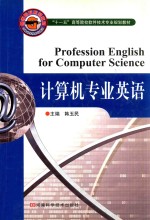图书介绍
计算机专业英语PDF|Epub|txt|kindle电子书版本网盘下载

- 韩玉民主编 著
- 出版社: 郑州:河南科学技术出版社
- ISBN:9787534938863
- 出版时间:2008
- 标注页数:251页
- 文件大小:43MB
- 文件页数:270页
- 主题词:电子计算机-英语-高等学校:技术学校-教材
PDF下载
下载说明
计算机专业英语PDF格式电子书版下载
下载的文件为RAR压缩包。需要使用解压软件进行解压得到PDF格式图书。建议使用BT下载工具Free Download Manager进行下载,简称FDM(免费,没有广告,支持多平台)。本站资源全部打包为BT种子。所以需要使用专业的BT下载软件进行下载。如BitComet qBittorrent uTorrent等BT下载工具。迅雷目前由于本站不是热门资源。不推荐使用!后期资源热门了。安装了迅雷也可以迅雷进行下载!
(文件页数 要大于 标注页数,上中下等多册电子书除外)
注意:本站所有压缩包均有解压码: 点击下载压缩包解压工具
图书目录
Chapter 1 Computer System1
1.1 System Components1
1.2 How a Computer Works2
1.3 Types of Computers2
1.3.1 Notebook Computer3
1.3.2 PC(Personal Computer)3
1.3.3 Workstation4
1.3.4 Server4
1.3.5 Minicomputer4
1.3.6 Mainframe4
1.3.7 Supercomputer5
Reading Material Brief History of Computer8
Chapter 2 Motherboard12
2.1 Form Factor13
2.2 Chipset14
2.3 BIOS Chip14
2.4 CMOS RAM Chip15
2.5 Sockets,slots and ports15
2.5.1 Sockets for CPUs16
2.5.2 Memory slots16
2.6 Buses16
Reading Material Intel Desktop Motherboard D975XBX219
Chapter 3 Processor22
3.1 Principles22
3.2 Processor Instructions23
3.3 Basic structure and processor operation24
3.4 CISC and RISC microprocessor25
3.5 64-bit Microprocessors26
3.6 Microprocessor performance factors27
Reading Material Multi-Core Processors30
Chapter 4 Memory System33
4.1 Memory Hierarchy33
4.2 Main Memory34
4.2.1 RAM34
4.2.2 ROM35
4.3 Auxiliary Memory36
4.3.1 Magnetic Discs36
4.3.2 Optical Discs37
Reading Material Bits and Bytes40
Chapter 5 Input Devices44
5.1 Keyboard44
5.2 Mouse45
5.3 Touch Screen46
5.4 Voice Recognition Devices47
5.5 Scanners47
Reading Material Input Device-Digital Cameras50
Chapter 6 Output Devices54
6.1 Monitor(Display Screen)54
6.1.1 CRT monitors55
6.1.2 LCD monitors55
6.1.3 Parameters of monitors56
6.2 Printer56
6.2.1 Dot-Matrix Impact Printers57
6.2.2 Dot-Matrix Thermal Printers57
6.2.3 Laser Printers57
6.2.4 Ink-Jet Printers58
6.2.5 Parameters of printer58
6.3 Other Output Devices58
Reading Material USB Overview61
Chapter 7 Operating System64
7.1 Basics of OS64
7.2 Boot-strapping65
7.3 Functions of Operating System66
7.3.1 Processor Management66
7.3.2 Memory and Storage Management67
7.3.3 Device Management67
7.3.4 Application and User Interface68
Reading Material Windows Vista:A clear breakthrough71
Chapter 8 Data Structure74
8.1 What is Data Structure?74
8.2 Why Data Structure?74
8.3 Typical Data Structures75
8.3.1 Stack75
8.3.2 Queue77
Reading Material What data structure do you need?79
Chapter 9 Programming Languages82
9.1 Development of programming language82
9.1.1 Machine language82
9.1.2 Assembly language83
9.1.3 High-level language84
9.2 OOP and OOPL85
9.2.1 OOPL85
9.2.2 Difference of OOP and traditional procedural programming85
9.2.3 The advantages of OOP87
Reading Material C# and Java89
Chapter 10 Database Technology93
10.1 Basic Concepts of Database93
10.2 DBMS benefits and Applications94
10.3 Relational Database94
10.4 SQL96
10.4.1 Queries96
10.4.2 Data manipulation97
10.4.3 Data definition97
10.4.4 Data control97
10.4.5 Transaction controls98
Reading Material SQL Server 2005100
Chapter 11 Software Engineering104
11.1 Introduction104
11.2 Techniques and Procedures106
11.2.1 Software life cycle model106
11.2.2 Software process model-Rapid Prototyping108
Reading Material Overview of OOP111
Chapter 12 Software Testing115
12.1 What is Software testing?115
12.2 Software Testing Methods116
12.3 Software Testing Process117
12.3.1 Unit testing117
12.3.2 Integration testing117
12.3.3 Validation testing117
12.3.4 System testing117
12.4 The Purposes of Software Testing118
12.4.1 To improve quality118
12.4.2 For Verification&Validation(V&V)118
12.4.3 For reliability estimation119
12.5 Conclusions119
Reading Material Measurements to Manage Software Maintenance122
Chapter 13 Software Documentation126
13.1 Document Categories126
13.1.1 Process documentation127
13.1.2 Product documentation127
13.2 Document structure129
13.3 Writing style130
Reading Material A Software Document Template:ACIS Science Instrument Software Requirements Specification133
Chapter 14 Computer Network137
14.1 What is Computer Network?137
14.2 Infrastructure138
14.3 Network Configuration(Topology)139
14.3.1 Star Network140
14.3.2 Bus Network140
14.3.3 Ring Network140
14.4 Protocol Hierarchies140
14.5 Network Management142
Reading Material Internet145
Chapter 15 WWW150
15.1 Introduction150
15.2 Search for information on the WWW151
15.3 Basic structure of WWW152
15.3.1 Web Server152
15.3.2 Web Browser153
15.3.3 HTTP(Hyper Text Transfer Protocol)153
Reading Material HTML,XML,DHTML155
Chapter 16 Internet Security159
16.1 Introduction159
16.2 Internet attacks160
16.3 Countermeasures or suggestions160
Reading Material Firewalls166
Chapter 17 Web Applications Development169
17.1 Introduction169
17.2 Application of Web170
17.3 The framework of web application development170
17.4 The process of web application development171
17.4.1 Envisioning the nature and direction of the project171
17.4.2 Devising the plan172
17.4.3 Development172
17.4.4 Testing,support and stability172
Reading Material ASP.NET and JSP175
Chapter 18 Office Automation178
18.1 The Basics of Office Automation179
18.1.1 Data Storage and Manipulation179
18.1.2 Data Exchange180
18.1.3 Data Management181
18.2 People,Tools,and the Workplace181
Reading Material MS Office 2007185
Chapter 19 Multimedia Technology189
19.1 What is the multimedia technology?189
19.2 Multimedia technologies189
19.2.1 Compression technology190
19.2.2 Video servers190
19.2.3 Admission control191
19.2.4 Digital watermarks191
19.3 Multimedia architecture191
19.3.1 Single-user stand-alone systems192
19.3.2 Multi-user systems192
19.4 Multimedia applications192
19.4.1 Home applications192
19.4.2 Video conferencing193
19.4.3 Education193
19.4.4 Digital libraries193
19.4.5 Virtual reality193
Reading Material Digital Audio and Digital Video196
参考译文200
第1章 计算机系统200
第2章 主板202
第3章 处理器205
第4章 存储器系统207
第5章 输入设备210
第6章 输出设备212
第7章 操作系统215
第8章 数据结构218
第9章 程序设计语言220
第10章 数据库技术222
第11章 软件工程226
第12章 软件测试228
第13章 软件文档231
第14章 计算机网络233
第15章 万维网237
第16章 因特网安全239
第17章 Web应用开发242
第18章 办公自动化244
第19章 多媒体技术247
References251